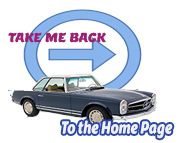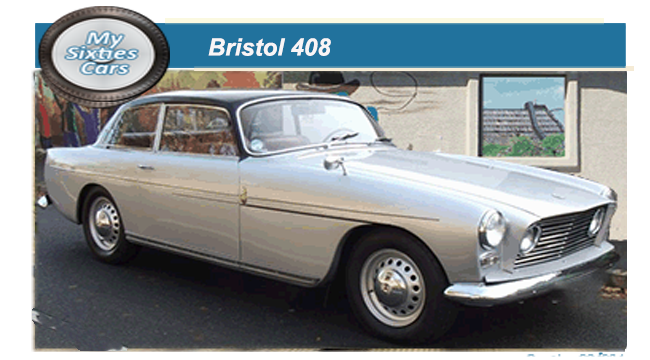
Evolution had always led the way at the Bristol car company, who over their ten-year existence had built up solid expertise, releasing a new model on a regular two-year cycle.
The new model carried forward all of the positive characteristics of the previous model(s) while adding several significant advances every time a new model hit the streets,
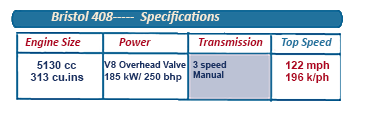 This was certainly the case with the introduction of the 408 in 1963, with the principal difference being in the powertrain of the new model.
This was certainly the case with the introduction of the 408 in 1963, with the principal difference being in the powertrain of the new model.
In late 1964, Chrysler Canada, in anticipation of a new trade agreement with the USA, increased the capacity of their 3I3ci V8 engines to 318ci (52 I I cc).
Installed in conjunction with a Chrysler Torqueflite three-speed automatic transmission, described as " a match made in heaven" with shifts under normal driving receiving praise for being virtually imperceptible.
G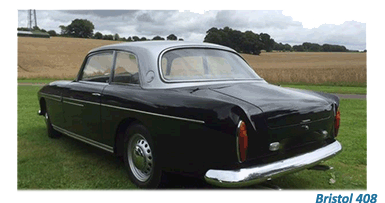 ear changes could be held at the touch of a button, although the motoring press agreed that 'acceleration on automatic could not be bettered by holding the individual gears,' while others stated that fitting an additional top gear would make for even more relaxed cruising.
ear changes could be held at the touch of a button, although the motoring press agreed that 'acceleration on automatic could not be bettered by holding the individual gears,' while others stated that fitting an additional top gear would make for even more relaxed cruising.
Squaring off the roofline reduced the overall height by I in (25mm) and, although the wheelbase remained the same as for the 407, the car's total length was reduced by some 4in (100mm), giving the 408 a more extended and lower appearance although it was in fact shorter.
![]()
To the casual observer, both these models were virtually identical, although those Bristol 408’s front end had been almost entirely revamped.
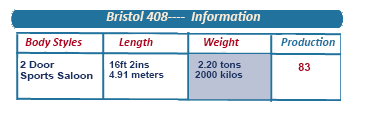 In place of the `Brabazon' intake was a wide, rectangular stainless-steel grille with two 53/4in (146mm) lamps recessed into the top corners.
In place of the `Brabazon' intake was a wide, rectangular stainless-steel grille with two 53/4in (146mm) lamps recessed into the top corners.
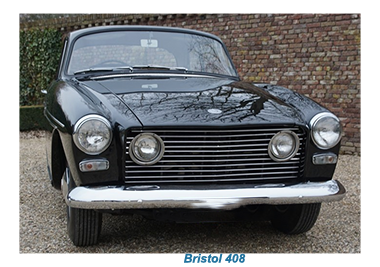 A large full-width chrome bumper wrapped around to enhance the short front overhang.
A large full-width chrome bumper wrapped around to enhance the short front overhang.
Although not to everybody's taste, when coupled with Twin-tone paintwork, such tailing did help to give the car a more contemporary air.
Small vestigial fins, formed at the top back edges of the rear bumpers, ran neatly into the back panel, shrouding the new oval-shaped clusters.
Reversing lights at either side of the flush-fitting license plate completed the rear light set.
Twin exhausts peaked out at either side of the car from below the bulky wrap-around bumper.
Once again unencumbered by a spare wheel, the boot was large enough swallow up to seven suitcases of varying sizes, as well as a couple of reasonably sized soft bags.
![]()
The 408 boot’s small opening was the subject of criticism by the motoring press towards the design team at Bristol, who ,as they claimed, in their pursuit of structural stiffness, had made 'loading and unloading rather heavy work.'
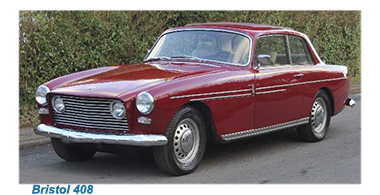 Helping to make the journey as pleasant as possible for driver and passengers alike, the 408 came with an updated ventilation system moved a higher volume of fresh air throughout the cabin.
Helping to make the journey as pleasant as possible for driver and passengers alike, the 408 came with an updated ventilation system moved a higher volume of fresh air throughout the cabin.
Inside, the car continued the Bristol tradition of leather, walnut and Wilton carpets to extract the maximum from the driving experience and the passenger to sit back and enjoy the journey.


